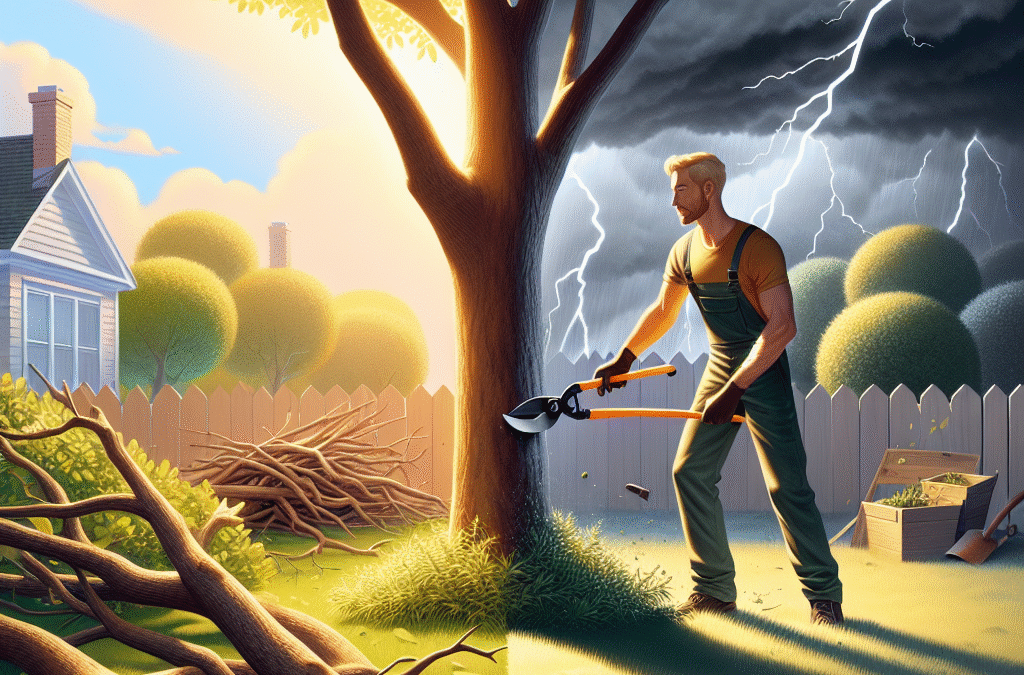Tree Trimming to Prevent Storm Damage: Tips and Tricks
When stormy weather strikes, the aftermath can be devastating, especially if trees on your property aren’t properly maintained. 🌳✨ Regular tree trimming is more than just a beauty regimen for your backyard—it’s a crucial step in preventing storm damage. In this post, we’ll explore some tips and tricks to keep your trees—and your home—safe from stormy weather. Let’s dive in!
Table of Contents
1. Why Trim Trees Before a Storm?
2. How to Identify Risky Trees
3. Best Times for Trimming
4. DIY vs. Professional Services
5. Conclusion
6. FAQs
Why Trim Trees Before a Storm?
Imagine waking up after a storm to find a large branch has fallen on your roof. 😱 Not the best way to start your day, right? Trimming trees helps to remove weak branches that could become projectiles during high winds. It’s like giving your trees a preventive haircut—snipping off the bits that could cause trouble. Moreover, well-trimmed trees are healthier and more resilient, making them less likely to suffer damage during a storm.
How to Identify Risky Trees
Not all trees pose the same level of risk. Some signs that a tree might need attention include:
🍂 Dead or dying branches
🌿 Dense canopies that prevent wind from passing through
🌳 Trees leaning precariously
🌱 Cracks or decay in the trunk
🪵 Branches that hang over structures or power lines
Identifying these problems early can save you a lot of hassle (and money) in the long run.
Best Times for Trimming
Timing is everything! The best time to trim your trees is during their dormant season, typically late winter to early spring. This is when they’re not actively growing, making it easier to see the structure and make precise cuts. However, if you spot a hazardous branch, it’s best to address it immediately, regardless of the season. ⚠️
DIY vs. Professional Services
Feeling brave enough to take on the task yourself? Here are a few things to consider:
🛠️ DIY: Great for small trees and minor trimming. Always use the right tools and prioritize safety. Never attempt to trim branches near power lines or those requiring a ladder.
👷 Professional Services: Ideal for large trees, complex jobs, or when you’re uncertain about safety. Professionals have the expertise and equipment to handle the job efficiently and safely.
Conclusion
Tree trimming is a vital part of storm preparedness. By maintaining your trees, you’re investing in the safety and aesthetics of your property. Whether you choose to do it yourself or hire professionals, the key is to be proactive. Storms may be unpredictable, but your preparation doesn’t have to be!
FAQs
Q: How often should I trim my trees?
A: Generally, trees should be trimmed every 3 to 5 years, but it depends on the species and growth rate. Regular inspections can help determine when trimming is needed.
Q: Can trimming my trees too much harm them?
A: Yes, excessive trimming can stress trees and make them vulnerable to disease. It’s important to trim only what’s necessary.
Q: Is it safe to trim trees myself?
A: For small trees and simple jobs, it can be safe if you use the right tools and precautions. For larger trees or complex situations, hiring a professional is recommended.
Q: What should I do with trimmed branches?
A: Consider composting smaller branches or use them as mulch. Larger branches may need to be disposed of according to local regulations.
Remember, a little maintenance goes a long way in keeping your home safe from storm damage. Happy trimming! 🌲😊

tree pruning companies Preston Hollow Dallas Texas

tree trimming service near me Lake Highlands Dallas Texas

tree trimming near me Lake Highlands Dallas Texas

tree pruning service near me Lakewood Dallas Texas

tree trimming service near me Preston Hollow Dallas Texas

tree trimming companies Lake Highlands Dallas Texas

tree trimming service near me Lakewood Dallas Texas

tree trimming service near me Highland Park Texas

tree trimming near me Preston Hollow Dallas Texas

tree trimming service near me Lake Highlands Dallas Texas
























































